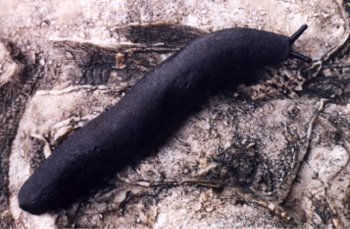Slime
by Valerie (July 5, 2000)
 There are some very slimy creatures living in our garden. The first of these is familiar to just about everyone. Slugs are considered to be one of the major pests of gardens since they are enthusiastic gourmands of just about every kind of plant we try to grow. They have very similar tastes to our own: the more we like a plant, the more they like it, and they show their appreciation by eating it to the ground. The only thing that they do more efficiently than eat plants is produce slime. Anyone who has ever touched a slug knows how difficult it is to get the slime off. It has very effective adhesive qualities. There are some very slimy creatures living in our garden. The first of these is familiar to just about everyone. Slugs are considered to be one of the major pests of gardens since they are enthusiastic gourmands of just about every kind of plant we try to grow. They have very similar tastes to our own: the more we like a plant, the more they like it, and they show their appreciation by eating it to the ground. The only thing that they do more efficiently than eat plants is produce slime. Anyone who has ever touched a slug knows how difficult it is to get the slime off. It has very effective adhesive qualities.
We have at least three species of slugs that live in our yard. Their populations vary considerably from year to year, depending on amount of rainfall and temperatures during the hottest and coldest times. Sometimes they eat almost all the new seedlings coming up and other times I hardly see any. Slugs loose moisture easily, so they hide under rocks and in other moist places to keep from dehydrating. The only kind of slug that is very common is one that is about an inch long, brown, and has a well-defined mantle. To me, these look like average, everyday slugs. The more interesting types are not as numerous, which is good since they are definitely larger and could do a lot of damage. One kind looks similar to the little slugs but it is about twice as large. It is a mottled brown color, has a smooth mantle, and the rest of its body is covered with a sharply defined mosaic of small tiles. The one pictured here is crawling over a decorative rock. The third type of slug is solid black in color and has no mantle (or else its mantle covers the whole body). It has no markings or textural differences along its three-inch length. The skin of this slug looks exactly like the rubber on tires after they've been in the sun a long time. This slug was photographed as it crawled over one of the fossil boulders we dug out of our yard and now use as decorations. I may have found slug eggs sometimes when I'm digging in the garden, but I'm not sure that's what they are. They look like tiny round pellets of fertilizer, with a brittle outer covering and gooey inside.
The other slimy creatures we have in our gardens are terrestrial flatworms. These are related to planarians and marine flatworms. As there are no native flatworms in North America, the ones in our garden were introduced with potted plants. They have much the same habits as slugs, in that they need to conserve moisture and so hide when it's hot and dry. The big difference between the two kinds of animals, however, is their feeding preferences: flatworms are carnivorous and eat worms, slugs and each other.
  This species is not very large, growing no longer than two inches. I have only seen this kind after heavy rains when they come out onto the sidewalk. This species is not very large, growing no longer than two inches. I have only seen this kind after heavy rains when they come out onto the sidewalk.
The other type of flatworm grows as long as eight inches (I measured one that was crawling along the foundation of the house) and is commonly called a land planarian (Bipalium kewense). Most are smaller and the one pictured here is only about three inches long. This flatworm has a definite head (shaped like a little shield) which is very sensitive and I've seen them "feel" their way along with great care. They are a yellowish color with a dark stripe running the whole length of their body. Even though they get very long, they don't get much wider, and resemble a long, sticky piece of string moving through the vegetation. Sometimes, during hot, dry weather, I find this species curled up in a ball, surrounded by a coating of slime, under rocks or bricks as it waits for better conditions. Land planarians can regenerate after being cut up, much like their freshwater counterparts. While they may eat a few earthworms, the terrestrial planarians are an unusual and interesting diversion, amazingly being able to survive in our hot, dry climate.  |
